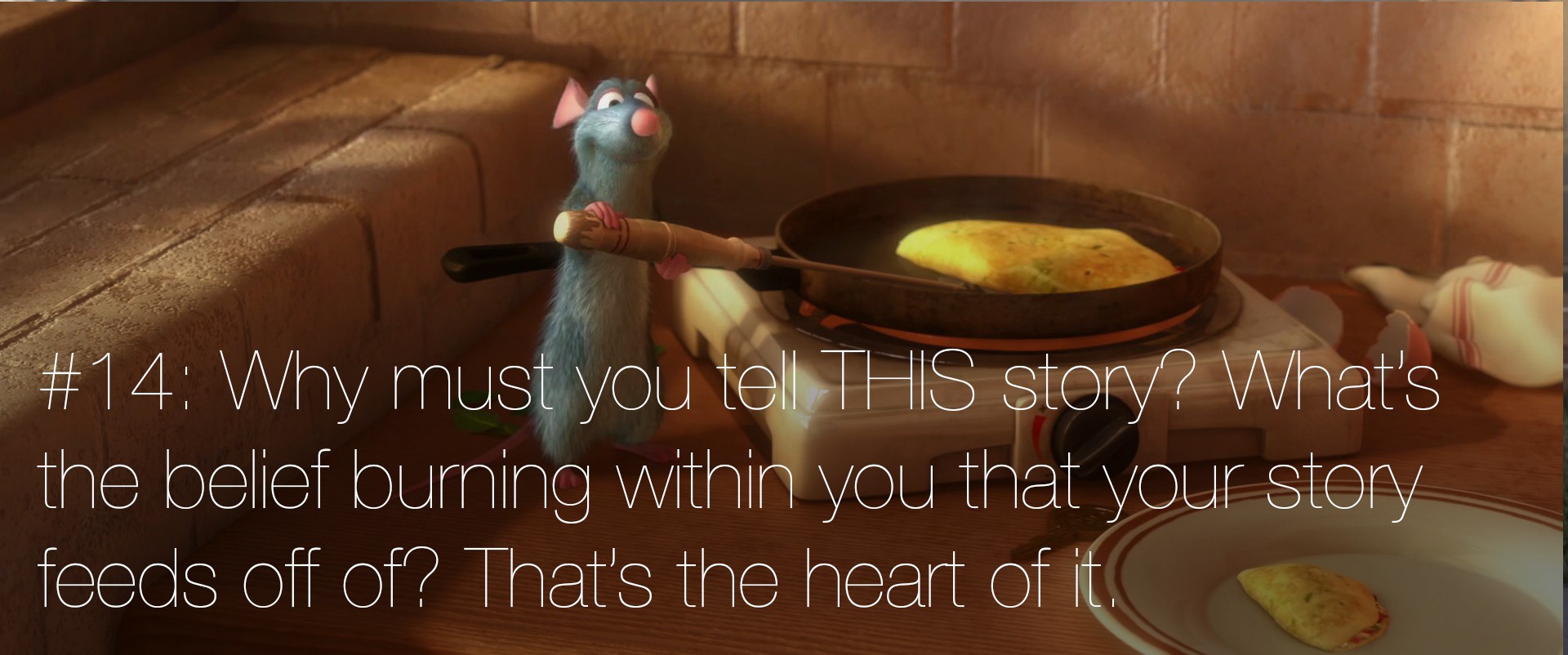A couple of years ago, then Pixar storyboard artist Emily Coats tweeted pieces of advice on making stories that she had picked up from working with Pixar, which were later compiled in several places on the internet, such as this io9 post. Later, Dino Ignacio created image macros of the individual rules which I am using in these posts.
Rule #14: “Why must you tell THIS story? What’s the belief burning within you that your story feeds off of? That’s the heart of it.”
This rule has two parts to it. The first comes into play early on in your process, when you’re trying to generate ideas or develop an idea that’s caught your fantasy. Maybe you have it in your head that you’d really like to run a game with an evil necromancer as the main antagonist. Poke at that idea a bit and figure out why it’s so appealing. Did you play a game or read a novel with an evil necromancer and found it appealing? Refer back to Rule #10 and pull that apart. Maybe you want to run a game with a lot of hack and slash violence, but don’t want your players getting distracted by the moral implications of killing the hundreds of ugly humanoids. Perhaps you want to use necromancy as a metaphor for the way in which the lives of dead people are twisted to serve the interests of the living. You’ve got to figure out what the real appeal of your story concept is to you before you can build on it.
Which brings us to the second part of this rule: Designing your story in a way that stays true to the heart. To continue with the necromancer example, you’re going to want to implement the undead in your game in very different ways depending on what you’re really getting at. If you’re imitating an antagonist from fiction, then you need to mimic that antagonist in a way that fits the setting and the game. If you’re simply using the undead as disposable opponents, then you don’t need to worry too much about where the bodies came from or who they were when they were alive, but need to be careful about throwing sentient undead into the mix. If, however, you’re using the undead as part of a metaphor about the living laying claim to the dead’s stories, then you not only need to know who that corpse was and what they stood for in life, but also need a way for the players to find out and a reason for them to care. Contrary to the game where the undead are disposable enemies, you’ll probably want to use intelligent, yet enslaved, undead early and often in order to develop the theme you’ve chosen.
A special note if you are considering this rule before you even have a core idea for your game: Don’t get caught up in worrying about whether your players will like your ideas, or whether the story in your head is “worth telling.” I know I’m normally all about tabletop roleplaying as a collaborative process with your players, but worrying about your players this early will be paralyzing because it is literally impossible to evaluate whether your players will enjoy a game until you have some concrete ideas established. Even an elevator pitch like “Want to play in a game where you fight lots of undead?” is meaningless without an idea about what that entails. Your player might say “That sounds awesome!” based on the idea that that means do-gooders valiantly opposing evil and then end up disappointed and bored when they find themselves in a survival-horror game.
Similarly, you shouldn’t focus on whether an idea is cliched or “been done.” At least, not in the early stages. “Evil necromancer” might be a concept that you’ve seen a lot, but whether your game will feel tired or cliched depends more on your execution, and you don’t know what your execution is going to be until you at least sketch an outline of it. Then, once you have something solid to critique, you can start worrying about tropes and stereotypes and make changes as necessary.
Basically, you need to pin down what it is about your story that grabs your attention and fires your enthusiasm first. Once you’ve figured out what it is, you can stay true to it throughout the game, even if you’re only planning one session at a time. Remember that enthusiasm is contagious. It’s a lot easier to get your players to care about a game that’s driven by something you care about. Moreover, you’ll find your interest in the game stretches farther if it’s saying something you believe in. And that will make things more satisfying all around.






